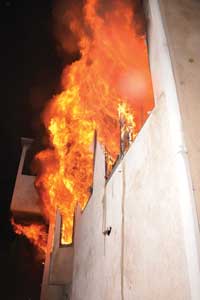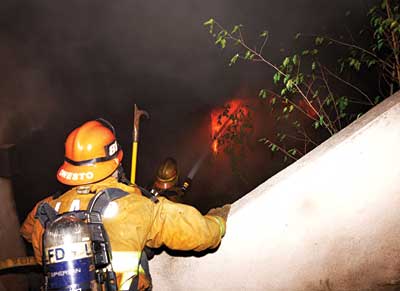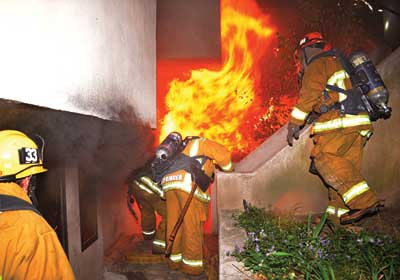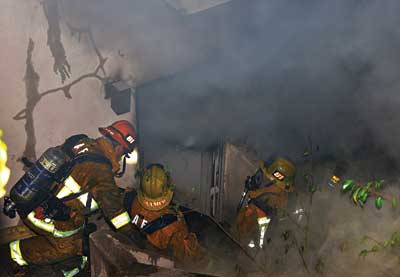By Erich Roden
In May 2013, Los Angeles (CA) Fire Department (LAFD) firefighters responded to an intense fire inside a three-story hillside home in Sherman Oaks, California. On arrival of the first-arriving fire companies, flames were visible out of four windows on the C side of the building. Seventeen fire companies, five rescue ambulances, four battalion command teams, three EMS battalion captains, and two urban search and rescue companies controlled the fire in approximately one hour. The loss was estimated at $260,000, and the cause was under investigation by the LAFD Arson Investigation Unit.
 |
| (1) LAFD firefighters responded to an advanced fire in a three-story private dwelling built on a hillside. The fire was on the first sublevel of the structure and rapidly extended to the rest of the dwelling. Since this sublevel fire floor is below the main entrance to the dwelling, it must be treated as a below-grade fire when determining strategy and tactics. (Photos by Rick McClure.) |
The private dwelling (fire building) was built on a hillside, creating a street-level entrance on the A side of the fire building with two sublevels descending into the hill on the C side. The fire was in the first sublevel, or one floor below street level, thereby presenting arriving firefighters with a severe below-grade fire. As a result, this created an immediate and probable life hazard on arrival for any victims occupying the bedrooms on the floor above.
Do not consider below-grade fires just of the basement or cellar variety. Many contemporary homes are built into their surroundings to make the best use of aesthetically appealing landscapes. This often creates difficult dwelling layouts for firefighters to operate in, as the life hazard is even more threatened by a fire below the occupied bedrooms and living areas. Furthermore, firefighters can anticipate living areas anywhere inside these types of dwellings.
 |
| (2) The dwelling also had a sublevel entrance door that directly serviced the fire floor. This was the location from which the second hoseline was stretched, placed, and operated to extinguish the main body of fire. Anytime a successive hoseline is stretched to an alternate entrance, everyone on the fireground must be made aware that this operation is taking place. |
Another below-grade concern at these types of dwellings is the presence of conventional window types and sizes on every level instead of the smaller ones most often found in the below-grade basement level of most conventional dwellings. This allows a tremendous amount of ventilation to rapidly spread fire throughout the structure when fire has self-vented these windows.
 |
| (3) The second hoseline begins operating and advancing into the sublevel fire floor. The first hoseline must not be tempted to advance down to the fire floor from its position on the floor above when another hoseline is tasked with extinguishing the below-grade fire. The first hoseline was stretched to protect the stairs and search on the floor above; it is paramount that this hoseline protect this position. |
Below-grade fires in sublevel dwellings are always two-hoseline fires at a minimum once more engine companies arrive. Once the interior stairs are located, a choice has to be made as to which door the first hoseline will advance through: the dwelling’s main entrance door or, in the case of this particular one, a sublevel entrance door to the fire floor that was also on the A side of the dwelling. The first hoseline was stretched to the former and the second hoseline to the latter for a very tactically significant reason: to simultaneously protect the occupants and searching firefighters and extinguish the heavy main body of fire.
 |
| (4) The second hoseline is flaked out for an advance into the fire floor while the first hoseline is being placed on the floor above. |
Once the decision is made to go to an alternate entrance with another hoseline, everyone responding and already on scene must be made aware of the position of the first hoseline. This decision should be made based on the location of the stairwell in conjunction with the adjacency of primary means of egress (interior stair) doors. In most private dwellings with a single-story, street level construct, the stairs to the basement or sublevels will be at the rear of the dwelling near the kitchen. This would require the first hoseline to traverse the living room to this area and then descend two floors to the main fire area at this fire. Although this would surely protect the primary means of egress and areas above the fire, one engine company would likely be delayed in getting the hoseline and its water down to the fire if later-arriving engines to help with the advance are minutes from the scene. This is a typical concern in many areas where hillside homes are prevalent in urban cities.
The first-arriving LAFD engine company protected the floor above the fire by keeping the hoseline placed between the fire and potential occupants through the street-level entrance. This also prevented fire from extending throughout the entire dwelling and allowed searching truck and rescue company firefighters to safely initiate and conduct the search.
 |
| (5) The fire was rapidly extinguished, the first floor was protected, and the search was rapidly and safely conducted because the engine companies coordinated proper placement and operation of the first two hoselines. This was accomplished under punishing conditions by determined and experienced firefighters. |
Opposing streams are not a major concern if the requisite communication between engine officers is conducted. The first-arriving engine officer must communicate with later-arriving engines as to the help needed with the first hoseline and when and if they will be starting water on the main body of fire. Engines stretching through the other entrance on this structure are one floor below and will be operating the hoseline that extinguishes the fire. The first-arriving engine’s hoseline must halt its advance until the fire is darkened down. Engine officers in this scenario must anticipate this type of communication and not try to “meet” the second-arriving engine below-grade until the fire is darkened down and the second hoseline has been shut down. Typically, the second hoseline will always back up the position and advancement of the first hoseline if this hoseline will be the one advancing below-grade. Conversely, at many below-grade fires, the first hoseline may simply be stretched to protect the floors above only, as the second hoseline would be the one that actually advances down to their location while the first hoseline vigilantly remains in this position. This is the strategy that the LAFD employed during this fire, and it proved very effective in controlling the fire. Any other plan by later-arriving engine companies not adhering to these fireground principles possibly puts everyone operating inside the dwelling in harm’s way.
The LAFD was faced with an extremely tough fire on arrival and experienced an even tougher firefight. Knowing that this fire was rapidly extending to the floors above, LAFD engine companies used good judgment in hoseline placement and were able to conduct interior operations, thereby giving any possible trapped occupants the best chances of survival.
ERICH RODEN is the co-editor of Urban Firefighter and is a battalion chief assigned to the Training Division of the Milwaukee (WI) Fire Department. He is a member of the FDIC Executive Advisory Board, is a lead instructor for the FDIC “Urban Essentials” H.O.T. evolution, and was previously a H.O.T. instructor for “Engine Company Operations.” He is also a fire service instructor for the Milwaukee Area Technical College.
More Fire Engineering Issue ArticlesFire Engineering Archives

